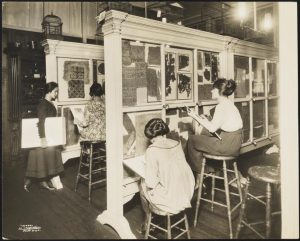This is a two-part series on the Hewitt sisters. Read part one.
By 1897, Sarah and Eleanor had collected enough to formally open their museum on the fourth floor of the Cooper Union. In the tradition of their grandfather, the Hewitt sisters wanted to actualize a museum and library that were not just a showcase, but also tools—places that students and designers could come to for reference and inspiration, then go out and create their own innovative objects. In the birth of the Cooper Union Museum for the Arts of Decoration, the sisters embodied the increasingly democratic attitudes that grew to dominate the 20th century. Their museum was to be open to everyone, with “no tedious restrictions and formalities,” which were often imposed by the exclusive art galleries of the era. Indeed, their museum provided a means for many women to gain economic independence through art and design.

In the late 1800s, American museums largely ignored the decorative arts, easing any competition the sisters faced during their European collecting trips. They would often supply many objects directly from their family (to their mother’s consternation). Wealthy and influential friends, such as J.P. Morgan, also generously contributed magnificent collections to the new museum. At the same time, the business as well as the pleasure of applied and decorative arts was starting to be treated seriously by influential New Yorkers. In the 1890s, magazine articles appeared suggesting that women might learn more about the decorative arts and even pursue careers in the field. The Hewitts’ initiative and philosophy matched well with this trend, with many women availing themselves of the museum. Indeed, with no paid staff, many prominent women and Hewitt friends like socialite Alva Vanderbilt, novelist Edith Wharton, and designer Elsie de Wolfe supported the enterprise.

The sisters would share responsibilities as directors of the museum until Eleanor’s death in 1924. Sarah would continue as director until her passing in 1930. The museum progressed throughout the 20th century, but by the early 1960s the museum and the Cooper Union lost the glue that held them together. In 1963, the Cooper Union announced the closure of the museum. Thankfully, this was not a popular decision to its many fans, and a committee led by Henry Francis Du Pont quickly formed to find a way to save it from its demise. Negotiations began that eventually resulted in the museum joining the Smithsonian Institution’s complex of museums. In 1968, with approval of the New York Supreme Court, the museum officially became a part of the Smithsonian. It would take almost a decade before anyone could see the collections again in person, reopening in its new location in the former mansion of Andrew Carnegie in 1976 as the Cooper-Hewitt Museum of Design. Under the guidance of the Smithsonian, the museum would undergo many more changes, including a few variations on the name and expansion to modern and contemporary design. After extensive renovations, including the move of the library to the nearby Fox mansion, the museum’s latest iteration as the Cooper Hewitt, Smithsonian Design Museum officially became public this past December. While the cutting-edge features—such as an interactive pen that digitally tracks your visit—would make the museum almost unrecognizable to the Hewitt sisters, they would be pleased by the continuation of their innovative and unique approach to museums.

The Cooper Hewitt, Smithsonian Design Library today consists of more than 90,000 volumes housed in the townhouses at 9 East 90th Street in New York and in an offsite facility in Newark, N.J. It is a world-class collection of books, serials, picture files, trade catalogs, and rare design and decorative arts material primarily covering the Renaissance to contemporary periods. The core of the nearly 10,000 rare architecture, pattern, decorative arts, children’s and natural history works were donated by the Hewitt family and their friends. The library works closely with the Cooper Hewitt Museum, supporting its research, collections, and exhibitions. Stephen Van Dyk [Head of the Smithsonian Libraries Art Department and Director of the Cooper Hewitt Library] notes, “The library continues the Hewitt legacy of being an accessible, working laboratory for designers as well as for all who study design and decorative arts.”

2 Comments
I am interested in the “DeCloux Room” and the “DeCloux Collection” can you give some insight as to why it is called that and to whom/what it named after?
Hi Chris,
Thanks for the question! Please check out the Cooper Hewitt’s page about Jean Leon DeCloux, for whom the collection was named: https://collection.cooperhewitt.org/people/18050561/
Apparently, the Parisian collector of ornament drawings befriended the Hewitt sisters in Paris and ended up donating much to the new museum.